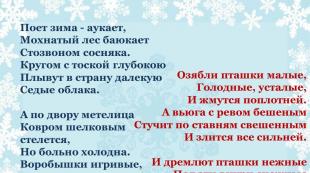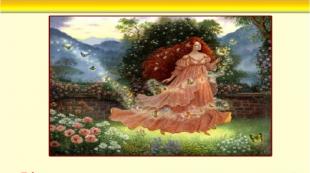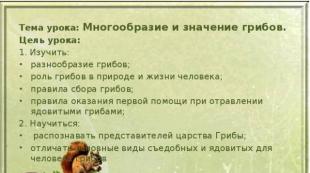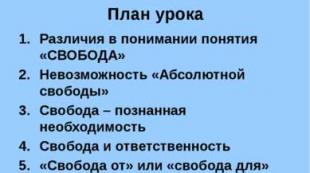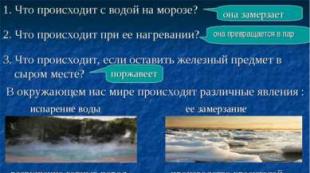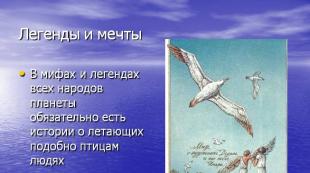The first reforms of the chosen one are glad. Lesson summary on the topic "reform of the elected glad"
By the end of the 1540s, under the young ruler Ivan IV, a circle of figures was formed, to whom he entrusted the conduct of affairs in the state. Later, Andrei Kurbsky called the new government "The Chosen Rada." Its most famous members were Adashev Alexei Fedorovich, confessor Sylvester, Mikhailovich - the head and several other noble princes.
Reforms of the Chosen One
The first steps towards reforms were meetings of nobles and governors. In 1549, the February meeting took place, which became the first Zemsky Sobor. The main political strategy of the Chosen One was the centralization of the Russian state according to the civilizational model of the West. The change in strategy required a set of reforms. The reforms of the Chosen Rada had an anti-boyar orientation. It relied on the landlords, nobles, townspeople, and therefore expressed exclusively their interests.
The elected council, whose reforms took place in 1549-1560, implemented transformations in all spheres of society. The changes affected the administrative, church, legal, financial and tax and other systems.
Reforms of the Chosen One in the legal and administrative systems
By decision of the "Council of Reconciliation" in 1549, a new code of laws was being prepared. The corrected Sudebnik was established in 1550. Relations between feudal lords and peasants have not changed, the old norms and laws have been preserved. At the same time, the power of feeders in the field was somewhat limited, and the process of forming orders was accelerated. Orders are the first functional governing bodies that were in charge of certain areas of state affairs (otherwise they were called chambers, courtyards, etc.). The most famous were the Petition, Streletsky, Posolsky and other orders.
At the same time, the centralization of local self-government was carried out. Viceroys were replaced by elected administrations. These and other innovations strengthened the positions of the nobles in society, united the provincial nobility into service cities.
Army reform
In the mid-50s of the 16th century, the Code of Service was adopted. A strict order of service was established. All landowners, regardless of the size of their possessions, became service people. The government organized and formed a detachment of archers to protect the king. As a result of military reforms, tens of thousands of soldiers received weapons, equipment and food.
Church reforms of the Chosen One
In 1551, Stoglav was adopted, in which one hundred chapters-articles were published on the answers of Ivan the Terrible about the structure of the church. Stoglav strengthened the general discipline in the church, regulated life. The tsar intended to confiscate land from the church, but these intentions were not approved by the Chosen Rada. The Church tried in every possible way to strengthen its authority, which was steadily falling in the eyes of the people.
Reforms of the Chosen One are glad in the financial system
No administrative reforms could be carried out without restructuring the tax system. In 1550, a census of the entire population was carried out. Household taxation was replaced by land taxation. In the central territory, a tax unit called the “big plow” was introduced, its value varied depending on the position of the landowners. The payment of taxes by the population became more and more centralized. "Feeding income" was replaced by a nationwide "feeding farm".
In general, the reforms of the Chosen Rada under Ivan the Terrible were ambiguous. They were of a compromise nature. The reforms contributed to strengthening power and improving the position of the nobility. Their implementation was interrupted due to the resignation of the Chosen One in 1560.
“The Chosen Rada” is a term introduced by Prince A. M. Kurbsky to refer to the circle of people who made up the informal government under Ivan the Terrible in 1549-1560.
Composition of the Elected Rada is the subject of discussion. Definitely, the priest Sylvester, close to the tsar, and the young nobleman Alexei Adashev participated in the "Rada". N. M. Karamzin includes Metropolitan Macarius. N. I. Kostomarov lists Vorotynsky, Serebryany, Gorbaty, Sheremetevs, princes Kurbsky and Kurlyatev.
The elected council lasted until 1560, after which most of its members were persecuted by Ivan the Terrible.
Table "Reforms of the Elected Rada"
Administrative reforms
Local government reforms
lip reform
The reform was launched during the reign of Ivan the Terrible's mother, Elena Glinskaya. Instead of princely proteges in the field (volostels and governors), the search for robbers and the trial of them passed to the labial elders, elected from local nobles, or labial kissers from the peasantry (if there were no nobles living in the area).
Zemstvo reform
The basis of the reform was laid in the Sudebnik of 1550. Peasant and urban communities received the right to submit a petition for the recall of the governor or volost, with the condition of electing elders from their own environment to establish a zemstvo hut, as well as transferring the “feeding” due to the governors to the state treasury (farmed farming).
The local self-government bodies created in this way received the opportunity to independently carry out judicial (except for serious crimes) and administrative functions, as well as collect and send taxes to the center.
Central government reform
creation of a system of orders
The expansion of the territory of the Russian kingdom with an acute shortage of administrative employees under Ivan III and Vasily III contributed to the formation of new government bodies - orders. But it was under Ivan IV the Terrible that the orders were combined into a single system of central government bodies, each of which was in charge of a special kind of state affairs or separate areas of the state. The orders were otherwise called chambers, huts, courtyards, palaces, thirds or quarters.

Judicial reform
The new Sudebnik of 1550, published to replace the outdated Sudebnik of 1497 (Ivan III), considered the following key issues:
- Conducting penalties for bribery
- Determination of the order of consideration of litigations
- Introduction of a stratification system of fines
- Rules for the trial of church ministers
- Limitation of local power
- Fight against robbers
- Legal duel rule changes
The creation of a unified, well-systematized and up-to-date regulatory document made it possible to significantly simplify and speed up the process of considering cases.
The introduction of restrictions on royal and princely henchmen (volostels and governors) and the transfer of part of the judicial functions to elected representatives from the population made it possible to reduce the crime rate and increase the efficiency of the local judicial system.
Economic reforms
tax reform
The Sudebnik of 1550 established a new taxation standard - big plow. Depending on belonging to the estate layer (peasantry, nobles or church), as well as on the quality of the land, the norm for a large plow differed.
The nobility, who, in addition to tax, also carried military service, paid at least half as much as peasants - a plow for a Black Hundred peasant was determined at 400 quarters, for a serviceman - 800.
In addition to the change in tax standards, among other changes that affected the economy during the reign of Ivano the Terrible together with the Chosen Rada, the following can be distinguished:
- Limiting the Financial Independence of the Church
- The decline of feudal independence
- Cancellation of feedings
Military reforms
Key points:
- 1550 Elected "Thousand Best Servants"
- 1550 - Elected archery army
- 1550 - Restriction of localism
- 1552 - Formation of horse hundreds
- 1555-1556 - Code of Service
- Reform of the military administration
- 1571 - Border charter
- Development of artillery
A set of measures carried out in the period 1550-1571 to increase the effectiveness and number of military formations, lay the foundations of the future regular army, improve subordination between military leaders and general coordination of the army, actually ensured the capture of Kazan in 1552, the assault on a number of fortresses during the Livonian War and the defeat of the Crimean Tatar army heading to plunder Moscow in the battle of Molodi in 1572.
Social reforms
Church reform
The set of laws (Stoglav), adopted at the Stoglav Cathedral in 1551, and concerning issues of church land ownership, religious images and clarifications regarding the correlation of various norms of state law with church law, was an attempt by Ivan the Terrible to streamline the church institution, which, in his opinion, pays too much attention to acquisitiveness and too little for the cultural education of the people.
reserved summers
Since 1581, when the government of Ivan the Terrible took up a general census of lands in order to determine the extent of the decline of the country's economy in the 1570-1580s (due to the oprichnina and the Livonian War), in some regions of the Russian state a ban was introduced on the peasant going out on the autumn Yuryev day. This prohibition for farmers to change the owner-landlord is interpreted by historians as the first step towards the subsequent enslavement of the main class of the country - the peasants.
The end of the chosen council - oprichnina
Disagreements between the tsar and the leaders of the "Chosen Rada" on foreign and domestic policy, as well as the support of Adashev and Sylvester for his cousin Ivan the Terrible during the tsar's illness, developed with Grozny's aspirations to accelerate the centralization of the Russian kingdom through further restriction of the rights and liberties of the nobles, the Boyar Duma, clergy.
In 1560 the tsar exiled Archpriest Sylvester to a monastery, and A.F. Adashev, put under guard in Derpt, where he died of a fever two months later - the king suspected both of being involved in the death of Empress Anastasia. A. M. Kurbsky fled, warned of disgrace, in 1564 at the height of the Livonian War.

An oprichnina army (several thousand people) was created, which was personally subordinate to Ivan the Terrible and received the right, on his orders, to deal with the “disgraced” (i.e., those convicted by the tsar) without the need to consult with the Boyar Duma. The entire territory of the country was divided into "Oprichina" - the personal possession of the king and "Zemshchina". According to various estimates of historians, from 5 to 15 thousand people were killed during the oprichnina. The property and lands of those who fell into disfavor with the king were subject to confiscation.

The oprichnina army could not repel the raid of the Crimean Khan Devlet-Giray in 1571, who burned the suburbs of Moscow - the tsar introduced a ban on the very mention of "oprichnina". At the same time, the royal inheritance changed its name from “oprichnina” to “yard”.
Results and results of the reforms of Ivan IV the Terrible
- Strengthening autocracy and centralization of power - the fight against the boyars, the freedom of specific princes, the decrease in the financial and administrative independence of the church
- Increasing the efficiency of local governments - the creation of provincial and zemstvo institutions, the formation of a class-representative monarchy
- Reforming the army - the formation of a local form of land tenure, archery regiments, the development of artillery
- Reforming the taxation system
- The first steps towards the enslavement of the peasants
- Defining Standards for Religious Practices
Reforms of the Chosen One . By the end of the 40s. under the young tsar, a circle of court figures is formed, to whom he entrusts the conduct of state affairs. This new government was later named by Prince Andrei Kurbsky "Chosen Rada" (rada - advice under the monarch). In fact, it was the so-called Middle Duma, composed of members especially close to the king "large" Boyar Duma. The main role was played in it by Alexei Fedorovich Adashev, from the rich Kostroma nobles, the tsar’s bed-keeper, who became a Duma nobleman by his will (the third rank in the Boyar Duma after the boyar and okolnichi), as well as the head of the Ambassadorial Prikaz (Ministry of Foreign Affairs of the 16th-17th centuries) Ivan Mikhailovich Viskovaty, Duma clerk (fourth Duma rank), confessor of Tsar Sylvester, several noble princes and boyars.
The end of February 1549 surprised the Muscovites with a magnificent and solemn action: along the streets adjacent to the Kremlin, in beautiful carriages, wagons, on horses decorated with rich harness, the boyars and metropolitan nobles, hierarchs and clerks gathered in the royal palace, making their way through the crowds of people . Their collection, called contemporaries "Cathedral of Reconciliation", heard the reproaches of the monarch for violence and extortion during his early childhood, when the boyars, “like fierce beasts, they did everything according to their will”. However, Ivan Vasilievich from angry reproaches he turned to action: calling on everyone to work together, he announced the need and the beginning of reforms.

According to the program outlined by this first in the history of Russia Zemsky collection, i.e., a representative body under the king, began with the transformation of the military. According to the verdict of 1550, local disputes between governors were banned during campaigns; all of them, in accordance with a strict routine, were subordinate to the first governor of a large regiment, that is, the commander in chief. In the same year, an army of archers appeared - warriors armed not only with cold weapons, like the noble cavalry, but also with firearms (they squeaked; the predecessors of the archers were called squeakers). Unlike the noble army, which was convened as a militia if necessary, the archers served constantly, received uniforms, monetary and grain salaries.
Reforms of Ivan IV the Terrible
According to Sudebnik 1550. , which replaced the old code, eliminated the privilege of monasteries not to pay taxes to the treasury, forbade turning boyar children from the nobility into slaves. The transition of peasants from one owner to another on St. George's Day was made more difficult by increasing the size of the elderly levied from them. The new code of laws strengthened control over the judicial activities of governors and volostels in cities, districts and volosts: the tsar and the Boyar Duma began to decide the most important cases in Moscow; in the localities, the elders and kissers (elected people from local townspeople and chernososhnye (free peasants) watched the trial.

A photo. Sudebnik of Ivan the Terrible.
Church Cathedral 1551 . adopted Stoglav, a collection of decisions of the council in the form of one hundred chapters-articles from answers to questions from Tsar Ivan about church affairs "building". He strengthened discipline, regulated church life - services and rituals in the church, everyday aspects of monastic and church life. But the tsar's intentions to confiscate the lands of the church and monasteries were not approved at the council.
In the middle of the century, the government organized a description of the lands. introduced a certain unit of land tax - a large plow. The same amount was taken from 500 quarters " "kind"(good) land in the same field as the black-mowed peasants; from 600 quarters - from church lands; from 800 quarters - from service feudal lords (landlords and estates).
Important reforms were carried out in central and local government. A system of orders is being formed in Moscow - boyars and clerks managed different affairs:
- Posolsky - external relations with neighboring states;
- Bit - a noble army, appointed governor to regiments, cities, led military operations;
- Local - endowed service people with lands;
- Streltsy - was in charge of the Streltsy army;
- Rogue - trial "dashing people";
- Great Parish - by collecting national taxes;
- Yamskaya - by the postal service (Yamskaya chase, pits - postal stations with coachmen);
- Zemsky - the protection of order in Moscow.
There was a kind "order over orders"- Petition, who sorted out complaints in various cases, thereby controlling other orders; it was headed by Adashev himself, the head "The Chosen One". As new lands were annexed to Russia, new orders arose - Kazan (in charge of the Volga region), Siberian.
In the mid 50s. completed the so-called lip reform, begun back in 1539: governors and volostels were deprived of the right to judge for the most important criminal offenses and transferred to the labial elders from among the local elected nobles.
They obeyed the Rogue Order. Then the power of governors and volostels (feeders) was completely eliminated. Now their functions were transferred to the organs of zemstvo self-government - in the person of "favorite heads" and their assistants - kissers. Both those and others were chosen from among their midst by local townspeople and black-haired peasants.
Service Code (1556) established a unified procedure for military service from estates and estates: from 150 acres of land, each nobleman must put up a warrior on horseback and in full armor ( “equestrian, crowded and armed”); additional monetary compensation was due for extra soldiers, and a fine for shortages. During campaigns, servicemen were paid a strictly defined salary - cash and bread. Periodic military reviews were introduced, dozens - lists of nobles by county.

They strengthened the state administration, the military system of the state, significantly contributed to its centralization. The tax system developed in the same direction - new taxes were introduced ( "food money"- for the maintenance of the archery army, "poor money"- for the ransom of captives), old taxes grew (for example, "pit money"- to the postal service "for city work"- construction of cities, fortresses). All transformations were aimed primarily at strengthening the power of the state. A policy of a kind of compromise was pursued - a combination of interests of all strata of the feudal lords, from small provincial nobles to noble boyars.
Elected Rada and oprichnina - two options for the development of the country
Names
Tsars:
Ivan IV Vasilyevich the Terrible (1533 – 1584) – son of Vasily III, Russian Tsar (since 1547), whose name is associated with the activities of the Chosen Rada, the holding of the oprichnina, the annexation of the Kazan and Astrakhan khanates, and the conduct of the Livonian War.
Fedor Ioannovich (1584 – 1598) – son of Ivan the Terrible, the last Rurik on the Russian throne.
Members of the Elected Rada:
Adashev A.F. – head of the petition order, was in charge of the personal archive of Ivan the Terrible, led all Russian diplomacy, in the 60s. fell into disgrace, perished in prison.
Viskovaty I.M.- Duma clerk, keeper of the state seal, de facto leader of Russia's foreign policy for 20 years; executed during the oprichnina.
Vorotynsky M.I.- prince, boyar and governor, hero of the capture of Kazan (1552); commanding the united detachments, he defeated the Tatars in the battle near the village of Molodi (1572); executed by Ivan IV.
Kurbsky A.M.- Prince, boyar, writer, participant in the Kazan campaigns, governor in the Livonian War; fearing disgrace, fled to Lithuania in 1564; author of three epistles to Ivan IV and "History of the Grand Duke of Moscow."
Macarius- the Moscow metropolitan, close to Vasily III, actively contributed to the establishment of the power of Ivan IV, under his influence and with his participation, Ivan IV took the title of king; supporter of a strong church.
Sylvester- priest, politician, author of the new edition of "Domostroy"; in 1560 removed from the court.
Guardsmen:
Basmanov A.D.– head of the oprichnina Duma.
Basmanov F.A. – son of Alexei Basmanov, guardsman and favorite of Ivan IV; when his father fell into disgrace, he killed his own father with his own hand, but he himself did not escape execution.
Skuratov Malyuta(G.L. Belsky) – a nobleman, one of the leaders of the oprichnina, the organizer of the murders of Vladimir Staritsky, Metropolitan Philip, led the executions during the oprichnina campaign in Novgorod, died during the Livonian War.
Vyazemsky A.I. – one of Grozny's chief advisers in organizing the oprichnina; enjoyed the unlimited confidence of his sovereign, who only took medicines prepared by the royal doctor from his hands; died during torture, accused of treason.
Historical figures:
Vladimir Staritsky– specific prince, cousin of Ivan IV, who was accused of plotting against the tsar and poisoned along with his entire family.
Ermak Timofeevich- Cossack ataman, who, with his campaign against the Siberian Khanate (beginning - 1581), laid the foundation for the annexation of Siberia to Russia.
Kuchum - the ruler of the Siberian Khanate; in 1581 he was defeated by Yermak's detachments, but continued to fight; killed in 1598.
Pimen- Archbishop of Novgorod, who suffered from the oprichnina terror.
Simeon Bekbulatovich– Tatar service khan, whom in 1575 Ivan IV "erected" to the royal throne instead of himself, while maintaining power in his hands (the latent period of the oprichnina).
Stefan Batory- a talented commander and statesman, since 1576 the head of the Commonwealth (formed in 1569), who won the Livonian War.
Philip– the metropolitan, who condemned the oprichnina, for which he was removed from his post, and then killed.
| CHOSEN RADA | OPRICHNINA | |
| Time | 1549-1560 | 1565-1572 (and further until the death of Ivan IV) |
| Essence | - government under the king; - Reformation policy with elements of democracy in management. | - the personal inheritance of the king; - a special policy of Ivan IV, aimed at strengthening autocratic power. |
| Representatives | okolnichy A.F.Adashev, priest Sylvester, Metropolitan Macarius, prince A.Kurbsky, M.Vorotynsky, D.Kurlyatev, clerk I.Viskovaty | A.D.Basmanov, F.A.Basmanov, Prince A.I.Vyazemsky, Malyuta Skuratov (G.L.Belsky), V.G.Gryaznoy |
| Content | reforms | counter-reforms |
| Main things, accomplishments | – reform of the central administration; – reform of local government; - judicial reform; - military reform; - church reform. | - division of the state into oprichnina and zemshchina; - despotism, terror, lawlessness; - opposition of the "oprichnina court" to the whole society, the conversion of all subjects into slaves. |
1. Central government reform:
· Convocation of the Zemsky Sobor
- the beginning of the formation of a class-representative monarchy;
- strengthening the central government;
- weakening of the class monopoly of the boyars;
- Strengthening the positions of the nobility.
· Creation of an order system
bit - in charge of the local army,
Pushkar - artillery,
petition - studies petitions sent to the king,
embassy - deals with foreign affairs,
local - in charge of state lands distributed to nobles,
Streltsy - manages the Streltsy army and city Cossacks,
zemsky - governs Moscow and some other cities,
armored - in charge of the manufacture of armor and other military arsenal,
robber - in charge of cases of robberies and robberies,
Kazan order - manages the south-eastern territories of Russia ...
· Restriction of localism
· Centralization of the financial and tax system (introduction of a single unit of taxation - the "big plow")
2. Local government reform:
· Zemstvo reform: the abolition of feeding
· Lip reform: the introduction of labial elders and zemstvo elders (elected positions of the local government system)
3. Judicial reform:
· Introduction of the Sudebnik of 1550
- expansion and systematization of legislation (compared to the Sudebnik of 1497);
- further enslavement of the peasantry:
§ clarified the norms for the transition of peasants on St. George's Day;
§ introduced the personal responsibility of the feudal lord for the crimes of the peasants.
4. Military reform:
· Creation of a permanent archery army
· Introduction of the noble militia (chosen thousand)
· The introduction of the "Code of Service", which regulated the military service of people "in the fatherland"
5. Church reform:
· Conducting Stoglav Cathedral
The reforms of the Chosen Rada became an overdue, necessary measure in the socio-political and economic life of the Russian state in the middle of the 17th century.
Formation of the Chosen One
In 1547, there was a popular uprising in Moscow, during which commoners killed a member of the royal family. The uprising was the result of the arbitrariness of the boyar rule, which was carried out in previous years, and revealed
the frank need to transform the state apparatus and develop political and legal norms of government in the state. To realize this goal, an actual unofficial government was created, which operated under Ivan the Terrible from 1547 to 1560 - the Chosen Rada. The reforms of this government were aimed at creating a high-quality bureaucratic system in the young Moscow kingdom, centralizing power, taking control of the situation throughout the country, and overcoming the remnants of feudal fragmentation. The composition of this government included some boyars, a number of nobles (who at that time were the court environment of the tsar and the boyars), clergymen and some government officials. Among them were confessor Sylvester, Prince Andrey Kurbsky, clerk Viskovaty, Metropolitan Macarius, nobleman Aldashev and other prominent figures of his time. However, the full composition of this body is unknown to us. Apparently, it did not have an exact number and was a situational gathering of persons close to the tsar who performed the role of an anti-crisis government.

Reforms of the Chosen One Rada under Ivan the Terrible
The main activities of this government were the following:

Oprichnina and the fall of the Chosen One
Over time, disagreements between the king and the aristocracy are growing. The reason for this was both personal hostility (which contributed to the first wife of Ivan IV), and disagreement about the pace of centralization of power. If the tsar sought to achieve the establishment of an absolute monarchy as soon as possible (the absolutization of royal power was characteristic not only for Russia, but for the whole of Europe), then the reforms of the Chosen Rada were aimed at evolutionary changes. All this led to the fall of the unofficial government and the emergence of the infamous guardsmen, who acted by simpler and more radical methods to strengthen the royal power and actually staged terror against the boyars.
